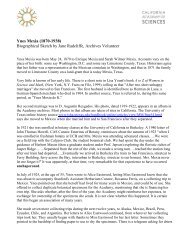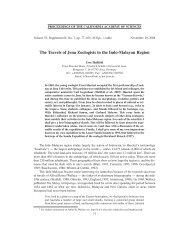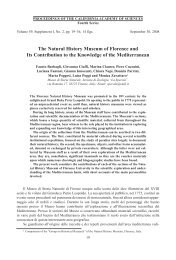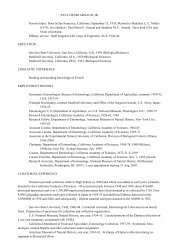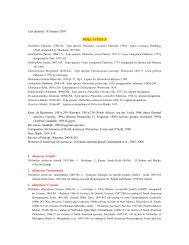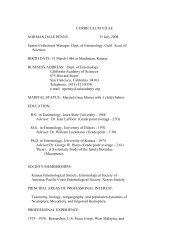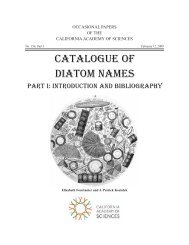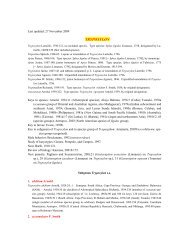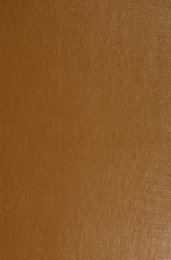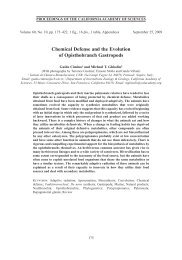PDF (9.91 MB) - Academy Research - California Academy of Sciences
PDF (9.91 MB) - Academy Research - California Academy of Sciences
PDF (9.91 MB) - Academy Research - California Academy of Sciences
You also want an ePaper? Increase the reach of your titles
YUMPU automatically turns print PDFs into web optimized ePapers that Google loves.
No. 16] AMPHIBIANS OF WESTERN NORTH AMERICA gQ<br />
Habits.— The habits <strong>of</strong> this spadefoot are similar to those <strong>of</strong><br />
Scaphiopus hammondii. In the spring <strong>of</strong> 1919, while the writer<br />
was on a trip from La Paz to San Jose del Cabo, Lower <strong>California</strong>,<br />
Mexico, a halt was made to rest the pack animals and to take<br />
shelter from an approaching thunder storm. During the storm<br />
the road became a rushing river, which however, quickly dried<br />
when the rain had passed, leaving a few puddles in the depressions.<br />
As if<br />
by magic these became filled with spadefoot toads till several<br />
hundred had congregated in two or three <strong>of</strong> the pools.<br />
These particular puddles were visited the next day and until they<br />
had dried up, but the toads never appeared again.<br />
Distribution.— Scaphiopus couchii ranges from Texas to Arizona<br />
south into Mexico. It is common in the Cape Region <strong>of</strong> Lower<br />
<strong>California</strong>.<br />
In Arizona, it has been collected in Cochise (Willcox, Fairbank),<br />
and Pima (Tucson, Roebles Ranch near Coyote Springs between<br />
Tucson and the Baboquivari Mountains) counties.<br />
In Sonora, it has been taken at Nogales.<br />
In Lower <strong>California</strong>, it has been secured at Cape San Lucas,<br />
San Jose del Cabo, Miraflores between La Paz and San Pedro,<br />
La Paz, Mulege, and San Ignacio.<br />
Family 6.<br />
BUFONID^<br />
In this family the vertebras are procoelus and without ribs;<br />
the sternum is usually a cartilaginous plate; the frontoparietals<br />
are completely ossified; the pterygoid<br />
bone is absent.<br />
Genus 12.<br />
Bufo<br />
Bufo Laurenti, Syn. Rept., 1768, p. 25 (type, vulgaris=bufo)<br />
.<br />
In this genus, the only one represented within the limits <strong>of</strong> this<br />
work, the pupil may be round or horizontal. The parotoid glands<br />
are always present. The skin is usually rough, covered with<br />
warts. The vomers are without teeth.<br />
Synopsis <strong>of</strong> Species and Subspecies<br />
a.— Cranial crests absent or obscure,<br />
b.— Cranial crests absent.<br />
c.— Parotoid glands widely separated; size larger,<br />
d.— Parotoid glands roundish, sole tubercles smaller.



